In 2025, the mini hair straightener market is valued at USD 3.1 billion and is projected to reach USD 4.8 billion by 2035, growing at a CAGR of 4.4%. The absolute dollar opportunity over this period is USD 1.7 billion, reflecting the additional market potential from 2025 to 2035. This growth indicates steady consumer demand and expanding adoption across regions. Businesses in the market can leverage this opportunity by increasing product availability, optimizing distribution networks, and targeting emerging customer segments to maximize revenue.
The incremental growth provides a clear financial pathway for investment planning and resource allocation. From a strategic standpoint, the USD 1.7 billion absolute dollar opportunity presents measurable potential for revenue expansion and market share growth. With the market steadily rising from USD 3.1 billion in 2025 to USD 4.8 billion in 2035 at a CAGR of 4.4%, companies can plan phased investments and scale operations accordingly. The predictable growth trajectory allows for careful production planning and marketing strategies that align with demand patterns. By focusing on key markets and improving accessibility, stakeholders can capture incremental revenue, enhance profitability, and strengthen their competitive position over the decade-long market expansion.
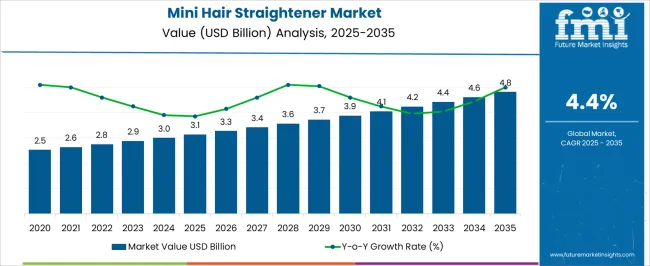
| Metric | Value |
|---|---|
| Mini Hair Straightener Market Estimated Value in (2025 E) | USD 3.1 billion |
| Mini Hair Straightener Market Forecast Value in (2035 F) | USD 4.8 billion |
| Forecast CAGR (2025 to 2035) | 4.4% |
A breakpoint analysis for the mini hair straightener market highlights key stages where growth accelerates or strategic shifts are needed. With the market valued at USD 3.1 billion in 2025 and projected to reach USD 4.8 billion by 2035 at a CAGR of 4.4%, early breakpoints appear around USD 3.6–3.7 billion. These levels represent initial momentum where rising consumer demand and market penetration create opportunities for expanding distribution, promotional efforts, and product availability.
Identifying these breakpoints allows companies to allocate resources efficiently, prioritize high-potential regions, and optimize sales strategies to capture incremental revenue during these growth phases. Later-stage breakpoints occur between USD 4.2–4.6 billion as the market approaches maturity and competition intensifies. Surpassing these thresholds may require businesses to refine pricing strategies, enhance customer engagement, and differentiate their offerings to maintain growth.
Monitoring these breakpoints ensures that companies anticipate shifts in demand and adjust operational and marketing plans accordingly. By aligning expansion efforts with these key thresholds, stakeholders can maximize revenue potential, strengthen market presence, and navigate the steady growth trajectory from 2025 to 2035 with greater confidence and precision.
The current market landscape reflects rising awareness of hair care and styling trends, especially among younger demographics and frequent travelers.
Advancements in heating technology and ergonomic design have enhanced product usability and safety, contributing to broader adoption. The market’s future outlook is buoyed by innovation in lightweight materials, fast heating plates, and cordless operation that offers enhanced convenience.
Growing penetration in emerging regions, coupled with expanding online retail channels, is further enabling market growth. Increasing preference for multifunctional and easy-to-use devices is anticipated to open additional avenues for product diversification and customization.
The mini hair straightener market is segmented by product type, power source, heating plate, pricing, consumer group, usage, distribution channel, and geographic regions. By product type, mini hair straightener market is divided into Flat iron and brushes, Hot air brushes, Curling irons, Straightening brushes, and Others.
In terms of power source, mini hair straightener market is classified into Cordless and Corded. Based on the heating plate, the mini hair straightener market is segmented into Ceramic plates, Titanium plates, Tourmaline plates, and Others (tourmaline ceramic, copper ceramic, etc.). By pricing, mini hair straightener market is segmented into Medium (USD 50-200), Low (USD 1 - USD 50), and High (>USD 200). By consumer group, mini hair straightener market is segmented into Women and Men.
By usage, mini hair straightener market is segmented into Residential and Commercial. By distribution channel, mini hair straightener market is segmented into Online and Offline. Regionally, the mini hair straightener industry is classified into North America, Latin America, Western Europe, Eastern Europe, Balkan & Baltic Countries, Russia & Belarus, Central Asia, East Asia, South Asia & Pacific, and the Middle East & Africa.
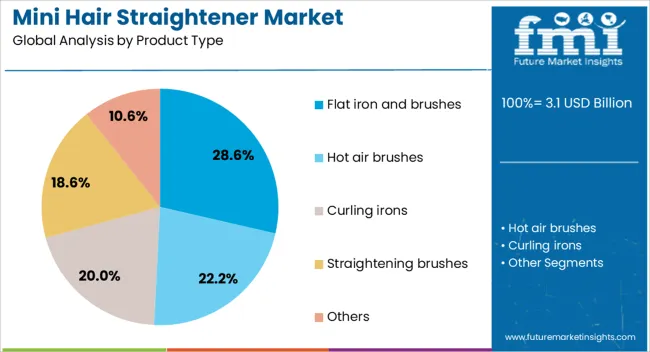
The flat iron and brushes segment is expected to hold 28.6% of the Mini Hair Straightener market revenue share in 2025, establishing it as a leading product type. This segment’s growth is attributed to its multifunctional design that combines straightening and brushing, which appeals to consumers seeking efficiency and time-saving grooming solutions.
The versatility offered by these devices has driven their adoption among individuals with varying hair types. Additionally, the ease of use and compatibility with different hair textures have supported the segment’s expansion.
The ability to deliver smooth and frizz-free results without the need for multiple tools further strengthens consumer preference for this product type.
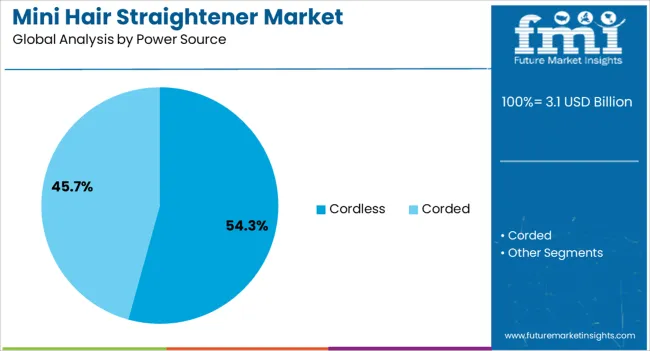
The cordless segment is projected to capture 54.3% of the market share based on power source in 2025, making it the dominant segment in this category. This dominance is primarily due to the increasing demand for portability and convenience, enabling users to style hair anytime and anywhere without being tethered to power outlets.
The rise in outdoor activities, travel frequency, and on-the-go lifestyles has heightened the appeal of cordless mini hair straighteners. Moreover, improvements in battery life and fast charging technologies have addressed previous limitations, allowing cordless devices to offer performance comparable to their corded counterparts.
The growing emphasis on cordless devices by manufacturers through product innovation and marketing campaigns has also contributed to the segment’s leading position.
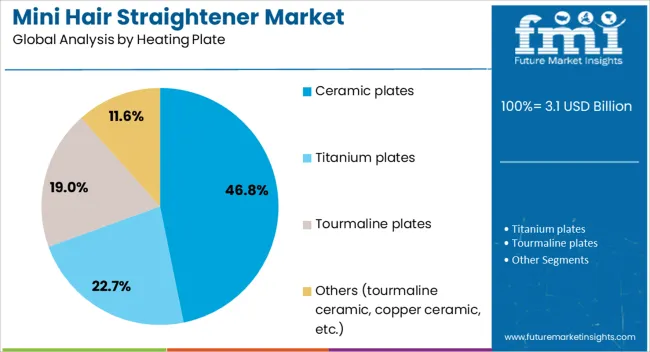
The ceramic plates segment is anticipated to hold 46.8% of the market revenue share based on heating plate type in 2025, marking it as the preferred heating technology. The segment’s growth is driven by the superior heat distribution and gentle styling experience that ceramic plates provide, reducing the risk of hair damage and breakage.
Ceramic heating technology is favored for its ability to maintain consistent temperatures and emit negative ions that help in smoothing hair cuticles, resulting in shinier and healthier-looking hair. Consumer preference for hair care solutions that combine effectiveness with protection has supported the widespread adoption of ceramic plate mini hair straighteners.
As awareness regarding hair health increases, this segment is expected to maintain a strong market presence.
The mini hair straightener market is expanding due to rising consumer focus on personal grooming, increased travel-friendly appliance demand, and the growth of home beauty routines. North America and Europe lead in adoption of premium, compact straighteners with advanced ceramic plates, temperature control, and dual-voltage functionality. Asia-Pacific is witnessing rapid growth due to rising disposable income, e-commerce penetration, and increasing adoption among young consumers.
Key manufacturers differentiate through plate material, heat-up speed, safety features, and ergonomic design. Market expansion is supported by lifestyle trends, influencer marketing, and the popularity of DIY hairstyling solutions. Companies providing lightweight, portable, and efficient devices gain an edge in professional and home-use segments, while regional players focus on affordable options for mass-market adoption. Device innovation and regional preferences significantly shape adoption patterns and brand competitiveness.
Mini hair straighteners differ in heating element type, plate material, and temperature range. North America and Europe favor ceramic or tourmaline plates for even heat distribution, smooth glide, and hair protection. Asia-Pacific consumers often adopt cost-efficient aluminum or hybrid plates suitable for basic styling needs. Differences in heating technology affect styling results, hair health, and long-term device durability. Leading global suppliers offer high-precision temperature control, rapid heat-up, and plate coatings to protect hair integrity. Regional manufacturers focus on affordability and functional simplicity. These contrasts influence adoption in professional versus consumer segments, brand positioning, and pricing strategies, with premium features driving growth in developed markets and basic usability targeting emerging markets.
Ergonomic design, lightweight construction, and built-in safety mechanisms determine user experience. European and North American consumers prefer dual-voltage, compact devices with automatic shut-off, anti-scald plates, and travel-friendly designs. Asia-Pacific buyers often prioritize portability and basic safety features at lower price points. Differences in design and safety impact usability, convenience, and customer satisfaction. Manufacturers emphasizing compact, easy-to-use, and safe devices capture premium segments, while regional suppliers cater to volume-driven, cost-conscious consumers. Variations in design and portability influence adoption rates, repeat purchases, and competitive differentiation across global and regional markets.
Mini hair straighteners are sold through online platforms, specialty beauty stores, and mass-market retailers. Europe and North America rely heavily on e-commerce, professional salons, and premium beauty outlets, while Asia-Pacific markets prioritize large-scale retail chains, online marketplaces, and direct-to-consumer channels. Differences in distribution affect pricing, product visibility, and market penetration. Leading manufacturers leverage multi-channel strategies and after-sales support, whereas regional producers focus on local retail partnerships. Distribution contrasts significantly influence adoption speed, brand recognition, and sales performance in both developed and emerging markets.
Regional demand is influenced by hair types, styling habits, and fashion trends. North America and Europe emphasize precision styling, protection from heat damage, and multifunctional devices suitable for diverse hair textures. Asia-Pacific consumers increasingly adopt portable straighteners for quick styling, travel, and everyday use. Differences in styling behavior affect product development, marketing strategies, and regional adoption. Companies offering devices that align with consumer hair needs and lifestyle preferences gain a competitive advantage. Regional manufacturers focus on affordability and basic functionality. Understanding these contrasts allows suppliers to optimize product features, target marketing campaigns, and position brands effectively across professional and mass-market segments.

| Country | CAGR |
|---|---|
| China | 5.9% |
| India | 5.5% |
| Germany | 5.1% |
| France | 4.6% |
| UK | 4.2% |
| USA | 3.7% |
| Brazil | 3.3% |
The global mini hair straightener market was projected to grow at a 4.4% CAGR through 2035, driven by demand in personal care, beauty, and travel-friendly grooming applications. Among BRICS nations, China recorded 5.9% growth as large-scale production facilities were commissioned and compliance with product quality and electrical safety standards was enforced, while India at 5.5% growth saw expansion of manufacturing units to meet rising regional consumer demand. In the OECD region, Germany at 5.1% maintained substantial output under strict electrical and cosmetic regulations, while the United Kingdom at 4.2% relied on moderate-scale operations for personal care and beauty segments. The USA, expanding at 3.7%, remained a mature market with steady demand across home and professional grooming, supported by adherence to federal and state-level safety and quality standards. This report includes insights on 40+ countries; the top five markets are shown here for reference.
Mini hair straightener market in China is growing at a CAGR of 5.9%. Between 2020 and 2024, growth was driven by rising personal grooming awareness, increased disposable income, and urbanization. Consumers preferred compact, travel-friendly, and affordable devices suitable for home and professional use. Manufacturers focused on ceramic and tourmaline plates, fast heating technology, and safety features. Online retail and e-commerce platforms expanded product accessibility across cities. In the forecast period 2025 to 2035, growth is expected to accelerate with adoption of smart, energy-efficient, and multifunctional straighteners. Rising beauty consciousness, international brand expansion, and social media influence on styling trends will further support market growth. China remains a leading market due to large urban population, high beauty device adoption, and growing middle-class consumer base.
Mini hair straightener market in India is growing at a CAGR of 5.5%. Historical period 2020 to 2024 saw growth driven by rising beauty consciousness, growing e-commerce penetration, and increasing disposable income among urban consumers. Manufacturers focused on compact, safe, and affordable devices with ceramic plates, fast heating, and voltage adaptability. Urban millennials and working professionals were key consumer segments. In the forecast period 2025 to 2035, market growth is expected to continue with adoption of smart, multifunctional, and energy-efficient devices. Social media influence, travel-friendly designs, and expansion of international brands will further boost demand. India is projected to maintain strong growth due to rising beauty device adoption, increasing focus on personal grooming, and growing urbanization.
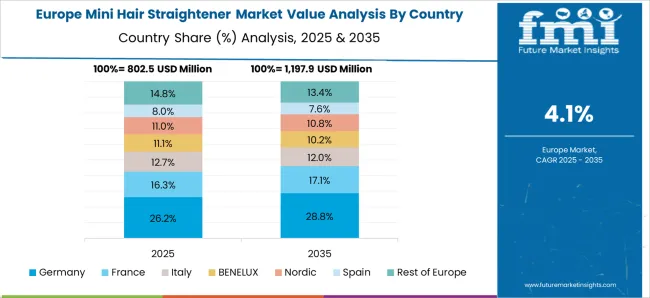
Mini hair straightener market in Germany is growing at a CAGR of 5.1%. Between 2020 and 2024, growth was supported by high consumer focus on personal grooming, adoption of premium beauty devices, and rising interest in portable styling tools. Manufacturers focused on advanced ceramic and tourmaline technologies, adjustable temperature, and ergonomic designs. Retail and online sales expanded product reach. In the forecast period 2025 to 2035, market growth is expected to continue steadily with adoption of energy-efficient, smart, and multifunctional straighteners. Sustainability, technological innovation, and consumer preference for high-quality styling devices will further support adoption. Germany remains a key European market due to high disposable income, beauty device adoption, and emphasis on product reliability and safety.
Mini hair straightener market in the United Kingdom is growing at a CAGR of 4.2%. During 2020 to 2024, adoption was driven by home styling trends, travel-friendly devices, and online retail availability. Manufacturers focused on compact, safe, and easy-to-use devices suitable for everyday use. Social media influence and beauty blogs increased consumer awareness. In the forecast period 2025 to 2035, market growth is expected to continue moderately with adoption of multifunctional, smart, and energy-efficient straighteners. Expansion of e-commerce platforms, rising beauty device awareness, and growing interest in portable styling tools will further support growth. The United Kingdom market demonstrates stable development with emphasis on convenience, safety, and device quality.
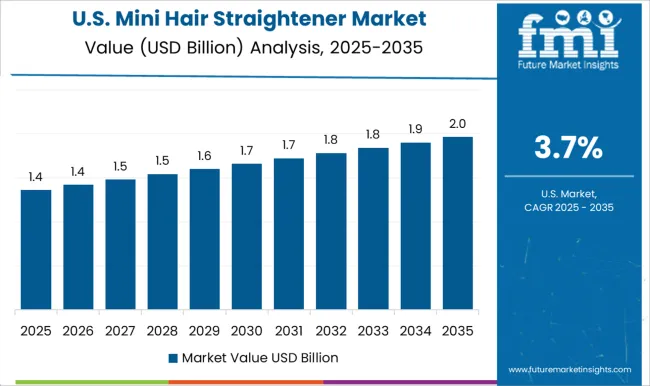
Mini hair straightener market in the United States is growing at a CAGR of 3.7%. Historical period 2020 to 2024 saw growth fueled by rising personal grooming trends, travel-friendly styling needs, and online retail expansion. Manufacturers focused on ceramic and tourmaline plates, fast heating, and compact, safe designs. Working professionals and students were key consumer segments. In the forecast period 2025 to 2035, growth is expected to continue steadily with adoption of energy-efficient, smart, and multifunctional devices. Increasing beauty awareness, social media influence, and focus on portability will further drive market expansion. The United States market demonstrates consistent growth with emphasis on convenience, safety, and advanced styling features.
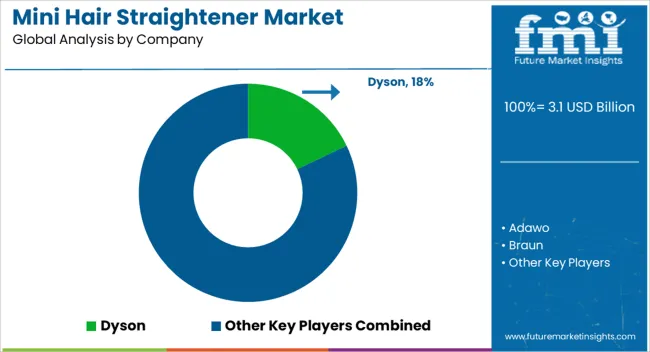
The mini hair straightener market is supplied by Dyson, Adawo, Braun, Conair, Drybar, Hot Tools, Ikonic, John Paul Mitchell, Moehair, Panasonic, Philips, Revlon, RUSK, T3 Micro, and Vega. Competition is shaped by heating technology, plate material, temperature control, size, and portability. Dyson and T3 Micro brochures highlight intelligent heat regulation, fast heating, and compact designs for travel. Braun and Philips emphasize ceramic-coated plates, variable temperature settings, and ergonomic handles. Conair and Revlon datasheets specify dual-voltage compatibility, safety shut-off features, and quick heat recovery. Observed patterns show rising demand for cordless, lightweight, and multi-functional straighteners for personal and professional styling. Strategies among suppliers focus on product differentiation, channel presence, and consumer experience.
Dyson and T3 Micro prioritize advanced heating sensors and precision styling features targeting premium segments. Braun and Philips invest in compact, lightweight models for convenience and portability. Adawo and Hot Tools highlight affordability with reliable performance for entry-level users. John Paul Mitchell and RUSK emphasize salon-grade performance and durability. Observed practices include optimizing plate material for smooth styling, offering travel-friendly designs, and maintaining compatibility with global voltage standards.
| Item | Value |
|---|---|
| Quantitative Units | USD 3.1 Billion |
| Product Type | Flat iron and brushes, Hot air brushes, Curling irons, Straightening brushes, and Others |
| Power Source | Cordless and Corded |
| Heating Plate | Ceramic plates, Titanium plates, Tourmaline plates, and Others (tourmaline ceramic, copper ceramic, etc.) |
| Pricing | Medium (USD 50-200), Low (USD 1 - USD 50), and High (>USD 200) |
| Consumer Group | Women and Men |
| Usage | Residential and Commercial |
| Distribution Channel | Online and Offline |
| Regions Covered | North America, Europe, Asia-Pacific, Latin America, Middle East & Africa |
| Country Covered | United States, Canada, Germany, France, United Kingdom, China, Japan, India, Brazil, South Africa |
| Key Companies Profiled | Dyson, Adawo, Braun, Conair, Drybar, Hot Tools, Ikonic, John Paul Mitchell, Moehair, Panasonic, Philips, Revlon, RUSK, T3 Micro, and Vega |
| Additional Attributes | Dollar sales vary by product type, including corded, cordless, and travel-sized mini hair straighteners; by application, such as personal grooming, professional salons, and travel use; by end-use, spanning individual consumers and beauty professionals; by region, led by North America, Europe, and Asia-Pacific. Growth is driven by rising beauty consciousness, demand for portable styling tools, and increasing travel convenience needs. |
The global mini hair straightener market is estimated to be valued at USD 3.1 billion in 2025.
The market size for the mini hair straightener market is projected to reach USD 4.8 billion by 2035.
The mini hair straightener market is expected to grow at a 4.4% CAGR between 2025 and 2035.
The key product types in mini hair straightener market are flat iron and brushes, hot air brushes, curling irons, straightening brushes and others.
In terms of power source, cordless segment to command 54.3% share in the mini hair straightener market in 2025.






Full Research Suite comprises of:
Market outlook & trends analysis
Interviews & case studies
Strategic recommendations
Vendor profiles & capabilities analysis
5-year forecasts
8 regions and 60+ country-level data splits
Market segment data splits
12 months of continuous data updates
DELIVERED AS:
PDF EXCEL ONLINE
Mining Remanufacturing Component Market Forecast Outlook 2025 to 2035
Mining Hose Market Size and Share Forecast Outlook 2025 to 2035
Mining Equipment Industry Analysis in Latin America Size and Share Forecast Outlook 2025 to 2035
Mining Tester Market Size and Share Forecast Outlook 2025 to 2035
Mining Lubricant Market Size and Share Forecast Outlook 2025 to 2035
Mini Cranes Market Size and Share Forecast Outlook 2025 to 2035
Mining Pneumatic Saw Market Size and Share Forecast Outlook 2025 to 2035
Mini Grid Market Size and Share Forecast Outlook 2025 to 2035
Mini POS Terminals Market Size and Share Forecast Outlook 2025 to 2035
Mini Track Machinery Market Size and Share Forecast Outlook 2025 to 2035
Minimally Invasive Spine Technologies Market Size and Share Forecast Outlook 2025 to 2035
Mining Drilling Service Market Size and Share Forecast Outlook 2025 to 2035
Minimally Invasive Laser Therapy Devices Market Size and Share Forecast Outlook 2025 to 2035
Mining Trucks Market Size and Share Forecast Outlook 2025 to 2035
Mini Drives Market Analysis Size and Share Forecast Outlook 2025 to 2035
Mini Packaging Market Size, Growth, and Forecast for 2025-2035
Miniprotein Supplement Market Size and Share Forecast Outlook 2025 to 2035
Mini Brew Fermenter Market Size and Share Forecast Outlook 2025 to 2035
Mining Dump Trucks Market Size and Share Forecast Outlook 2025 to 2035
Mini Refillable Perfume Bottles Market Size and Share Forecast Outlook 2025 to 2035

Thank you!
You will receive an email from our Business Development Manager. Please be sure to check your SPAM/JUNK folder too.
Chat With
MaRIA